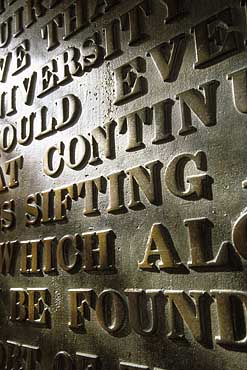Whatever may be the limitations which trammel inquiry elsewhere, we believe that the great state University of Wisconsin should ever encourage that continual and fearless sifting and winnowing by which alone the truth can be found.
1894 Board Of Regents, University of Wisconsin-Madison

Having spent more years on the campus of the University of Wisconsin than I will confess, this motto is forever etched in memory.
Over the years, I’ve developed a far greater affection for the substantial value of and necessity for sifting and winnowing; this notion of making an effort to carefully examine facts and intentionally separate the trivial from the consequential. It’s an active process. One that’s intentional, mindful, and relies on a thoughtful consideration of the merits of the messages offered.
It’s never been easy. In fact, it’s intrinsically difficult. We are bombarded daily with communications and messages that clamor for our attention. I recently read that we see some 490,000 words per day and we speak an average of 16,000 words per day (If, like me, you have teenagers with a Facebook page and unlimited text messaging plans, then you realize these are conservative estimates).
The information age has made it an even more formidable challenge. The knowledge economy we live in today has greatly, and perhaps forever, altered the very essence of sifting and winnowing. How do we take time today to actively attend to what matters most?
In many circumstances, we can’t. There’s not enough information.
Sometimes, it’s been directly engineered out of the human experience. Chat, text messaging, Twitter, and other modes of communication relying on sound bytes don’t easily lend themselves to sifting and winnowing.
In other cases, information overload may interfere with or interrupt our efforts to sift and winnow.
The toll extracted for multitasking through e-mails, cell calls, text messages, and surfing websites is profound. A study conducted by Gloria Mark, a Professor in the Department of Informatics at the University of California, Irvine suggests that we are interrupted every three minutes and five seconds during the course of the work day.
At least one-half of these are “self interruptions;” occasions where, for no obvious reason, we abandon the task we’re focused on to make another call, send another e-mail, or visit another web site. Here’s the rub. Following each interruption, it takes an average of 23 minutes and 15 seconds to get back to the task at hand. At best, this makes sifting and winnowing a more arduous and inefficient process.
Our blog – Connecting the Dots – is dedicated to those with a passion for sifting and winnowing through the crowded informational landscape concerned with the customer experience.
Our mission is to contribute to and nurture a genuine marketplace dialogue about how to improve the customer experience.
I had hoped to elaborate on some of our ambitious plans for this forum, but in the time I’ve taken to write this first entry, I’ve received 55 e-mails, 8 text messages from my daughter, 11 voice mails, and three webinar invitations.
Here’s to sifting and winnowing.

